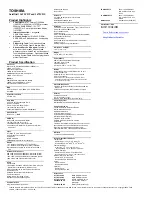
User’s Manual
6-4
Power and Power-Up Modes
Battery
When the AC power cord is not connected, the computer’s main power
source is a removable lithium ion battery pack, also referred to in this
manual as the battery. You can purchase additional battery packs for
extended use of the computer away from an AC power source.
The battery recharges the RTC batteries. The battery maintains the state of
the computer when you enable Resume.
To ensure that the battery pack maintains its maximum capacity, operate
the computer on battery power at least once a month until the battery pack
is fully discharged. Refer to
in this chapter for
procedures. If the computer is continuously operated on AC power, more
than a month, the battery may fail to retain a charge. It may not function
efficiently over the expected life of the battery and the Battery LED may not
indicate a low-battery condition.
Real time clock battery
The Real Time Clock (RTC) battery provides power for the internal real
time clock and calendar. It also maintains the system configuration.
If the RTC battery becomes completely discharged, the system loses this
data and the real time clock and calendar stop working. The following
message appears when you turn on the power:
Check system. Then press [F1] key . . . .
The battery pack is a lithium ion battery, which can explode if not properly
replaced, used, handled or disposed of. Dispose of the battery as required
by local ordinances or regulations. Use only batteries recommended by
TOSHIBA as replacements
When the computer is powered off in Resume mode, and the AC adaptor
is not connected, the battery pack supply power to maintain data and
programs in memory. If the battery pack is completely discharged, Resume
does not function and the computer loses all data in memory.
The following message appears when you turn on the power:
ERROR 0271:Check date and time settings.
WARNING 0251:System CMOS checksum bad -
Default configuration used.
Press <F1> to resume, <F2> to Setup.
















































